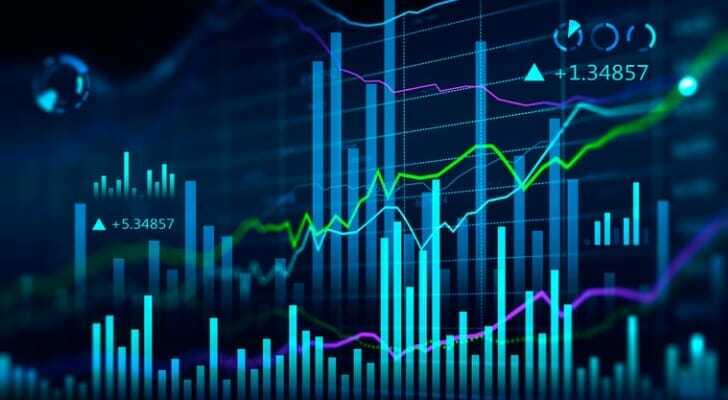 The secondary market is where investors buy and sell previously issued securities. It is important to the economy because it promotes capital formation and provides for price discovery based on the economic laws of supply and demand. In addition, it enhances liquidity and, because it is heavily regulated, gives participants a measure of assurance that business can be conducted safely and with a measure of predictability. Here’s what you need to know about secondary markets.
The secondary market is where investors buy and sell previously issued securities. It is important to the economy because it promotes capital formation and provides for price discovery based on the economic laws of supply and demand. In addition, it enhances liquidity and, because it is heavily regulated, gives participants a measure of assurance that business can be conducted safely and with a measure of predictability. Here’s what you need to know about secondary markets.
Consider working with a financial advisor to identify and begin investing in the markets that fit your goals, timeline and risk profile.
Secondary Market, Explained
When a company issues securities, they are created in the primary market. After the securities are issued, they are bought and sold in the secondary market. If you buy newly issued stock from Microsoft, you are buying stock released into the primary market. Typically, shares of new stock are purchased in the primary market by large investors. The money from investors who buy Microsoft’s new stock is used by the company for financing its operations. Smaller investors trade in the secondary market.
After the issuance of the securities, the investors who initially bought them from Microsoft sell them to investors who want to make a profit. When investors start buying the shares of Microsoft from each other rather than from the company, they are trading in the secondary market. The money from buying and selling the shares of Microsoft in the secondary market, provided the price is rising, is a gain for investors. Microsoft has already received its financing from its equity issue from the investors who purchased the stock directly from the tech giant in the primary market.
The major players in the secondary market are the broker-dealers who facilitate trading as well as corporations and private individuals. Other major players are financial intermediaries like banks, nonbank financial institutions and insurance companies along with advisory service providers like commission stockbrokers.
Role of the Secondary Market

The role of the secondary market is important for several reasons. The secondary market helps drive the economy and is usually a leading indicator of where economic activity is headed. It serves as a barometer of economic activity. Other functions of the second market are:
- Investment platform – The secondary market is a platform for investors to enter into buying and selling securities to and from each other.
- Continuous Market for Securities – The secondary market operates continuously to facilitate trading securities between its participants. There are a plethora of securities of many large, medium and small companies. If an investor doesn’t like one investment, there are more to choose from.
- Liquidity – Liquidity is the ability of an asset to be converted quickly to cash. Securities are usually more liquid than physical assets, but they are less liquid than cash itself and bank demand deposits. Liquidity in the secondary market refers to the rapidity with which securities can be bought and sold without causing much fluctuation. As the volume traded for a security increases, so does liquidity. Liquidity is valuable in complex economies.
- Transactions Costs – The secondary market lowers the transactions costs associated with buying and selling financial assets due to the high volume of transactions.
- Safety for Investor’s Money – The secondary market is so vital for our economy and its liquidity and capital formation that it is heavily regulated by the government. The regulations ensure that fraud will be at a minimum.
- Reacts Quickly to News – There is very little time lag between economic and company news and its reflection in the price of securities.
Types of Secondary Market Securities
The major types of securities that trade in the secondary market are divided up into three broad categories:
- Fixed-Income Securities – Bonds are one example of fixed income securities that trade in the secondary market. The income from them is fixed because the investor in bonds receives fixed interest payments and the principal back at maturity.
- Variable-Income Securities – Stocks and derivatives are classified as variable income securities since their income varies with supply and demand.
- Hybrid Securities – Convertible debentures are a type of hybrid security that has characteristics of both debt and equity.
Types of Secondary Markets
These securities trade in the two major types of secondary markets. Those are stock exchanges and over-the-counter market. A stock exchange is a centralized trading platform. An example is the New York Stock Exchange. Trading is conducted through the exchange and buyers and sellers never meet. The exchange is where investors can conduct transactions without fear due to regulatory oversight.
The second type of secondary market is the over-the-counter (OTC) market. There is no centralized trading platform. Instead, the OTC market is a vast network of computers and telephones. There is much competition in the OTC market with everyone juggling for the best price. The parties in the OTC market deal with each other, so there is more risk than when trading through the exchange.
The Bottom Line
 Secondary markets are an important part of a functioning economy. The secondary market is made up of a huge interconnected system of independent trades. Through this system, and based on the economic forces of supply and demand, the individual securities being traded are driven toward a fair market valuation. Individual securities obtain added economic value. As a result of secondary market activity, almost every market price in most economic sectors, for real assets and financial assets, is more efficient.
Secondary markets are an important part of a functioning economy. The secondary market is made up of a huge interconnected system of independent trades. Through this system, and based on the economic forces of supply and demand, the individual securities being traded are driven toward a fair market valuation. Individual securities obtain added economic value. As a result of secondary market activity, almost every market price in most economic sectors, for real assets and financial assets, is more efficient.
Tips on Investing
- If you are ready to tune up your investment portfolio, a financial advisor could help you. Finding one doesn’t have to be difficult. SmartAsset’s financial advisor matching tool can connect you to financial advisors in your area in just a few minutes. If you’re ready, get started now.
- If you would like to see an estimate of how your investments will perform, go to SmartAsset’s investment calculator. By inputting just a few variables, you can gain a wealth of information.
Photo credit: ©iStock.com/FreshSplash, ©iStock.com/ismagilov, ©iStock.com/metamorworks